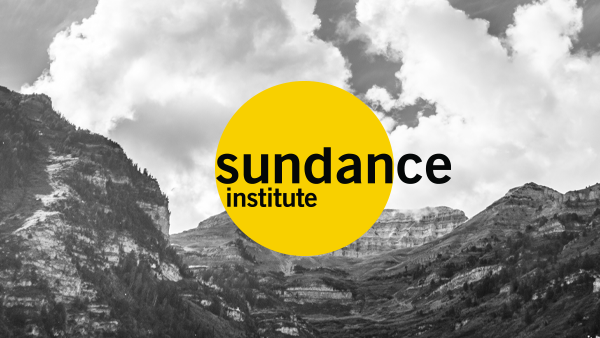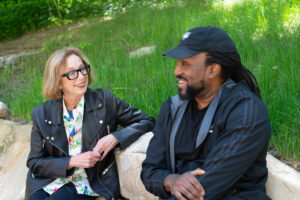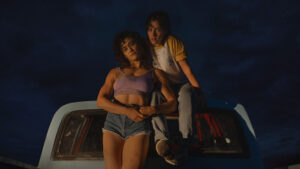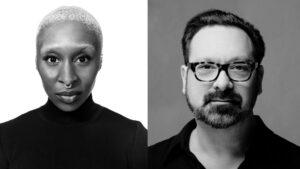Christopher Hibma
The 2011 Theatre Lab has reached the end of Week Two in the Canadian Rockies. Here are some thoughts from Sundance Institute artists at The Banff Centre:

Producing Artistic Director Philip Himberg and Lab participant Chita Rivera. Photo by Robert Petkoff.
By Philip Himberg
Producing Artistic Director
We are nearing the end of our second week here in beautiful Banff. I keep thinking that spring is around the corner, but when I drew the curtain in my room this morning, there was a full four or so inches of new ‘powder’ – white and glistening – and one of those huge deer grazing by herself in the field below. I imagine she’s searching for morsels of food under the ground cover. So are our playwrights – searching for some clarity and answers to questions they have about their scripts. Week Two is almost always a bit fraught, a bit anxious. The excitement and optimism of experiencing a new place gives way as the reality of play structure and character arcs come into focus. “Why is a scene not landing?” “Why am I unclear as to exactly what I want to say?” Perhaps what I want to say has changed: influenced by hearing my words out loud or by achieving a kind of new perspective? This is the rigorous and oftentimes frustrating work of making new theatre. There is still a great deal of joy here too! On Monday night, our Lab participant Chita Rivera, multiple Tony Award winner and recipient of the Kennedy Center Honors, did a question and answer for the community – discussing her work with Jerome Robbins (she was the original Anita in West Side Story) and Bob Fosse (the original company of Chicago). We screened her 1969 Fosse directed film, Sweet Charity, starring Shirley MacLaine. What a treat! Most of the Lab folks had never seen this adaptation of the Broadway musical, and we laughed and wept and most of all swooned at the genius of Mr. Fosse – and our own Chita! Tuesday night brought the most extraordinary concert by Lila Downs and her band. Lila and her husband Paul are co-composers on Like Water for Chocolate as well as performers in it. Lila graciously gave the stage over to other Lab artists who did spoken word, as world class musicians played music with her, danced, and celebrated the coming together of many diverse cultures. We also hosted Katie Steger from the Andrew W. Mellon Foundation, one of our funding partners. On Thursday night I gathered five artists to discuss Sundance Institute and the American new play development landscape with Katie over dinner. Later, I met with all of our playwrights to see how it’s going, what is working and what we can do even better. We’re heading to the home stretch of final presentations next week, but first, a group trip to stunning Lake Louise on Sunday!

Like Water for Chocolate actress Marisa Bernal. Photo by Robert Petkoff.
By Marisa Bernal
Actor – Like Water for Chocolate
Week One of our Sundance Institute workshop ended with a Lab-wide jam session. Despite the consuming energy of rehearsals and the desire to hike and swim and live it up at The Banff Centre, many artists pulled something together and performed in the more casual setting of the Maclab Bistro. The sun set over the Canadian Rockies and we started to play: piano virtuosos, accordion players, swing dancers, Lazzi actors, African political pop singers, original poets, and spoken word artists, to name a few. It was one of the most varied and extraordinary evenings I’ve witnessed in a long time, and it was heartwarming to note the shared appreciation for all of our diverse talents. I stood in the back and watched as a hip-hop dancer who had just made my jaw drop smacked a pillar with his fist because he was so excited about a fellow artist performing a Puccini aria. It’s this kind of enthusiasm about art — in all its forms — that makes Sundance Institute such a rare and remarkable organization. Perhaps the best thing of all, though, was that in between acts, the dance music started pumping and we completely forgot our different talents and backgrounds. We just hit the dance floor — to celebrate and enjoy the beauty of each other and our good fortune to be together on this ride.
By Otis Ramsey-Zoe
Dramaturg – Wild With Happy and Stuck Elevator
Week Two. Time seems to have hidden itself away somehow. This day could be yesterday, could be tomorrow, or today could extend and last as long as three days. I can’t tell the difference between the days—Monday, Tuesday, Friday? That is a part of the strange enchantment of this place. There is a timelessness. The advantage to this sense of place divorced from time is that we just keep working. Day by day we plow forward, and so much gets done. I have the privilege of working on two completely different projects in completely different places with such different needs. Each day I am surprised by a writer’s productivity. In a day’s time—whatever that is—a writer goes away and returns with a completely new draft of the script. We read it and it feels like it should have taken three or four days to write—the changes are that vast. In the seductive beauty of these mountains time expands; the outside world, though only a 10-minute walk away, feels like it could be located off in a distant forever.

Theatre Lab at Banff participants. Photo by Lisa Maydwell.
By Julianne Just
Assistant to Philip Himberg
Cal Arts Affiliate Artist
It is the end of the second week, and it is amazing how much the work has developed in such a short time. It is so inspiring to be surround by so many talented and generous people. From my perspective, there are a lot of things that make Sundance Institute special: the diversity of the work and artists; the sense of community; and the time and space to discover, create, explore, and push the work without the pressure of working towards a final production. This is a place to take artistic risks, to go deep, and to work (and play) hard. I have been lucky enough to spend time in all the rehearsal rooms watching people work, and it is fascinating how different the process is in each. Some groups are working primarily at the table, reading the script out loud, focusing in on what is on the page. Others are working on their feet, staging sections of the text and doing improvisations to see how the physical life of the story and characters might want to influence the script as it is written. One thing that is consistent in all the rooms is the conversation. A deep sense of trust can be felt in the rehearsal spaces, which allows for very open and free dialogue about the work. Many of these conversations seem to come back to very basic, but important questions: What is the story? Who are these characters? And what do you want the audience to take away from the experience? Of course, how you engage these questions is the challenge. And when you aren’t working, there is this amazing landscape to enjoy. On our Sunday off, a group of us went for an ice walk. It was absolutely stunning. Making theater, spending time engaging with wonderful, talented people, and getting to enjoy breathtaking natural landscapes — what could be better!




